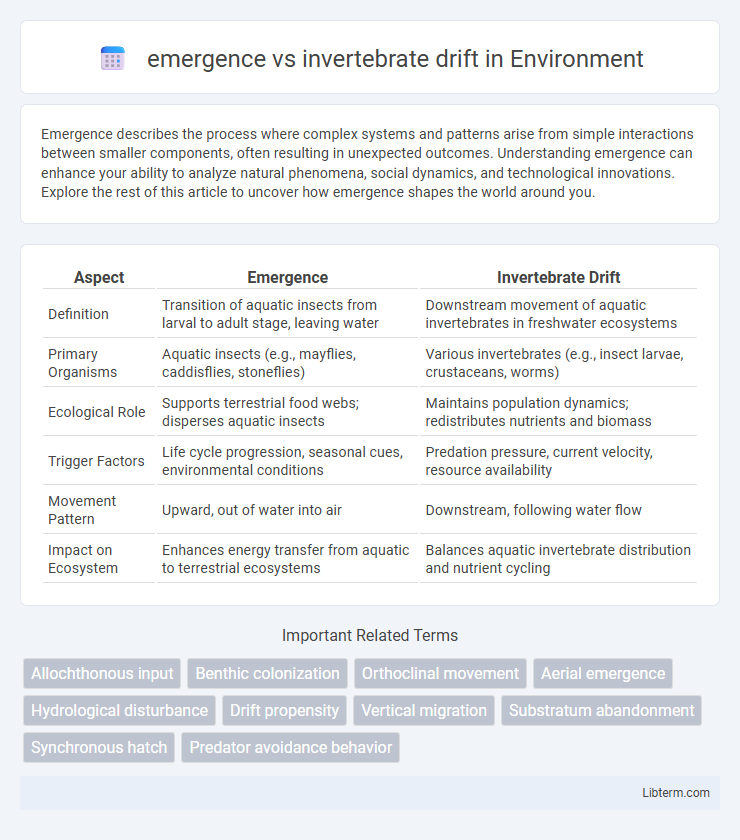Emergence describes the process where complex systems and patterns arise from simple interactions between smaller components, often resulting in unexpected outcomes. Understanding emergence can enhance your ability to analyze natural phenomena, social dynamics, and technological innovations. Explore the rest of this article to uncover how emergence shapes the world around you.
Table of Comparison
| Aspect | Emergence | Invertebrate Drift |
|---|---|---|
| Definition | Transition of aquatic insects from larval to adult stage, leaving water | Downstream movement of aquatic invertebrates in freshwater ecosystems |
| Primary Organisms | Aquatic insects (e.g., mayflies, caddisflies, stoneflies) | Various invertebrates (e.g., insect larvae, crustaceans, worms) |
| Ecological Role | Supports terrestrial food webs; disperses aquatic insects | Maintains population dynamics; redistributes nutrients and biomass |
| Trigger Factors | Life cycle progression, seasonal cues, environmental conditions | Predation pressure, current velocity, resource availability |
| Movement Pattern | Upward, out of water into air | Downstream, following water flow |
| Impact on Ecosystem | Enhances energy transfer from aquatic to terrestrial ecosystems | Balances aquatic invertebrate distribution and nutrient cycling |
Introduction to Emergence and Invertebrate Drift
Emergence refers to aquatic insects transitioning from immature stages in water to winged adults, playing a critical role in nutrient cycling and food webs within freshwater ecosystems. Invertebrate drift involves the downstream movement of aquatic invertebrates in response to environmental conditions, influencing population dispersal and availability as prey for fish. Understanding both emergence and invertebrate drift is essential for studying freshwater stream ecology and managing sustainable aquatic habitats.
Defining Emergence in Aquatic Ecosystems
Emergence in aquatic ecosystems refers to the critical life stage when aquatic insects transition from their juvenile aquatic form to their adult terrestrial phase, often involving a synchronized movement to the water surface. This process plays a significant role in nutrient cycling and energy transfer between aquatic and terrestrial ecosystems, contributing to the food web dynamics. Unlike invertebrate drift, which involves passive downstream movement of aquatic organisms within the water column, emergence is an active biological event crucial for species reproduction and dispersal.
Understanding Invertebrate Drift Dynamics
Understanding invertebrate drift dynamics involves analyzing the patterns and triggers of invertebrate movement in aquatic ecosystems, which are influenced by factors like flow velocity, predator presence, and habitat structure. Emergence refers to the transition of aquatic invertebrates from larval stages to terrestrial adults, significantly affecting invertebrate drift by altering community composition and availability. Studying both emergence and invertebrate drift provides critical insights into energy transfer, nutrient cycling, and ecosystem health in freshwater environments.
Key Differences Between Emergence and Drift
Emergence is the process where aquatic invertebrates transition from their larval to adult stages, actively moving from water to air, while invertebrate drift involves passive downstream movement within the water column, often caused by current or behavioral factors. Key differences include the direction and purpose of movement: emergence is an upward, life-cycle driven behavior aimed at maturation and reproduction, whereas drift is predominantly downstream and can serve as a dispersal or escape mechanism. Temporal patterns also differ, with emergence typically occurring during specific life stages and peak times, while drift can occur continuously or episodically influenced by environmental conditions.
Environmental Factors Influencing Emergence
Environmental factors such as water temperature, flow velocity, and photoperiod significantly influence the timing and intensity of emergence in aquatic invertebrates. Variations in substrate type and nutrient availability also affect emergence rates by altering habitat suitability and food resource distribution. These factors interact to regulate the population dynamics and drift patterns of invertebrate communities in freshwater ecosystems.
Drivers of Invertebrate Drift in Streams
Invertebrate drift in streams is primarily driven by abiotic factors such as flow velocity, turbidity, and diel light cycles, which influence the timing and intensity of downstream movement. Biotic interactions, including predation pressure and competition, also play crucial roles in modulating drift behavior and facilitating resource redistribution. Understanding these drivers enables improved predictions of aquatic ecosystem functioning and informs conservation strategies targeting invertebrate community dynamics.
Ecological Roles of Emerging Insects
Emerging insects play a critical ecological role by transferring energy and nutrients from aquatic to terrestrial ecosystems, providing a vital food source for birds, bats, and other predators. Their synchronized emergence events contribute to nutrient cycling and support biodiversity by sustaining diverse terrestrial food webs. In contrast, invertebrate drift influences aquatic community structure by redistributing organisms downstream, affecting predator-prey dynamics and resource availability within freshwater habitats.
Impacts of Drift on Stream Food Webs
Invertebrate drift significantly influences stream food webs by supplying a continuous downstream transport of nutrients and energy, affecting the spatial distribution of aquatic organisms. Drift impacts predator-prey interactions by providing a predictable food resource for drift-feeding fish and invertebrates, thus shaping community structure and trophic dynamics. The balance between emergence and drift governs nutrient cycling and habitat connectivity, ultimately supporting biodiversity and ecosystem resilience in lotic environments.
Methodologies for Studying Emergence and Drift
Sampling techniques such as emergence traps and drift nets are essential for studying emergence and invertebrate drift, providing quantitative data on species composition and abundance. Controlled field experiments incorporate standardized trap placements and sampling intervals to capture temporal and spatial variations in emergence and drift patterns. Data analysis often involves multivariate statistical methods and biomass measurements to assess community structure and ecological processes driving invertebrate movements.
Implications for Freshwater Management and Conservation
Emergence and invertebrate drift play crucial roles in freshwater ecosystem dynamics, influencing nutrient cycling, food web interactions, and habitat connectivity. Understanding the timing and magnitude of emergence events compared to drift patterns enables more effective management of aquatic biodiversity and the preservation of ecosystem services. Incorporating these processes into freshwater conservation strategies supports habitat restoration, mitigates the impacts of pollution, and enhances resilience against climate change effects.
emergence Infographic

 libterm.com
libterm.com